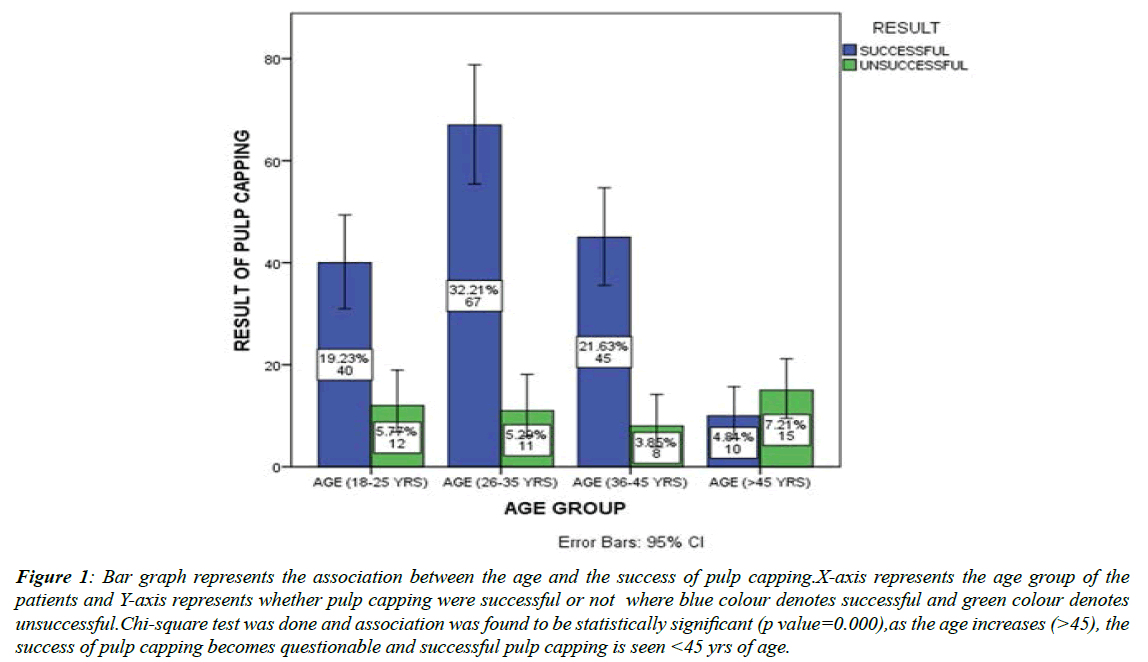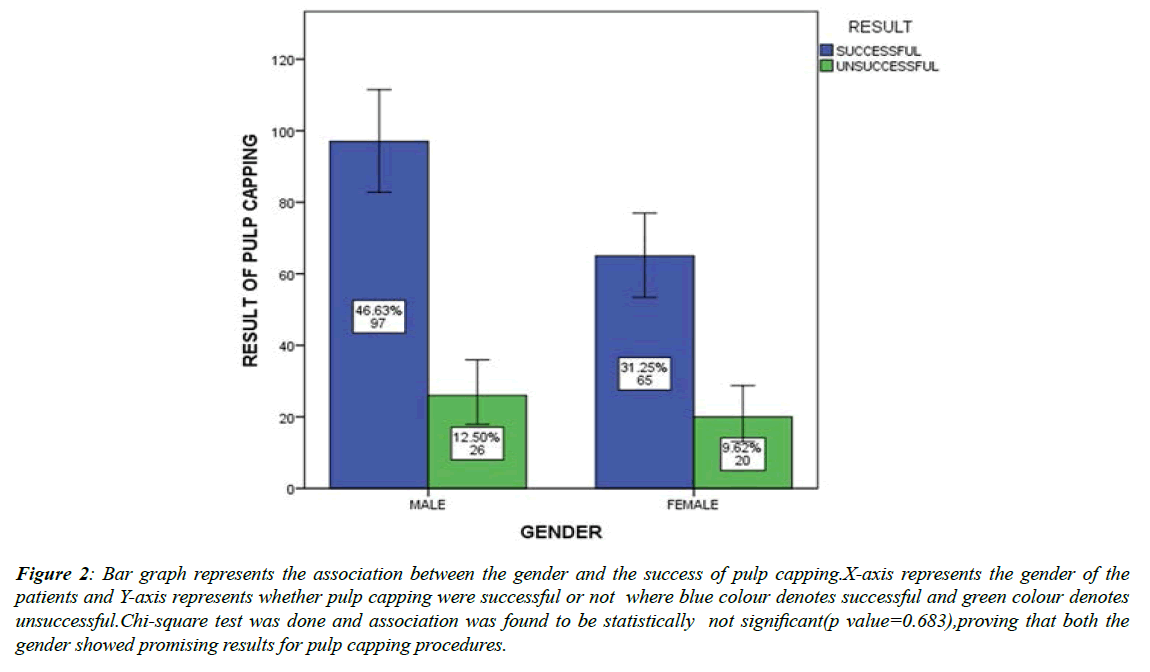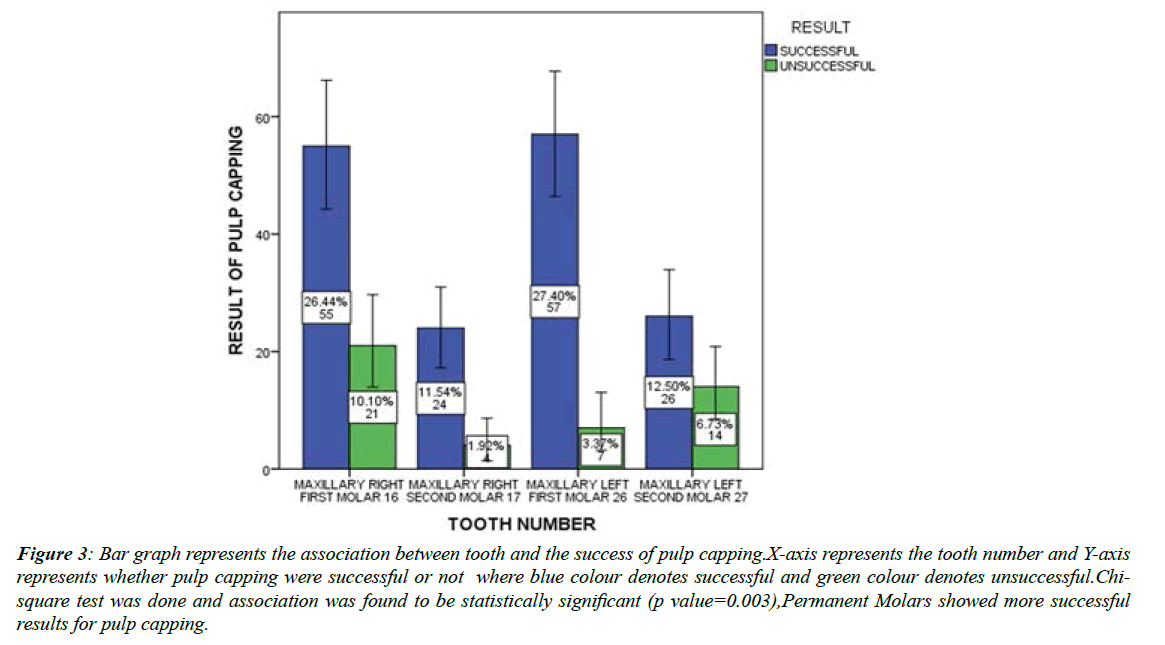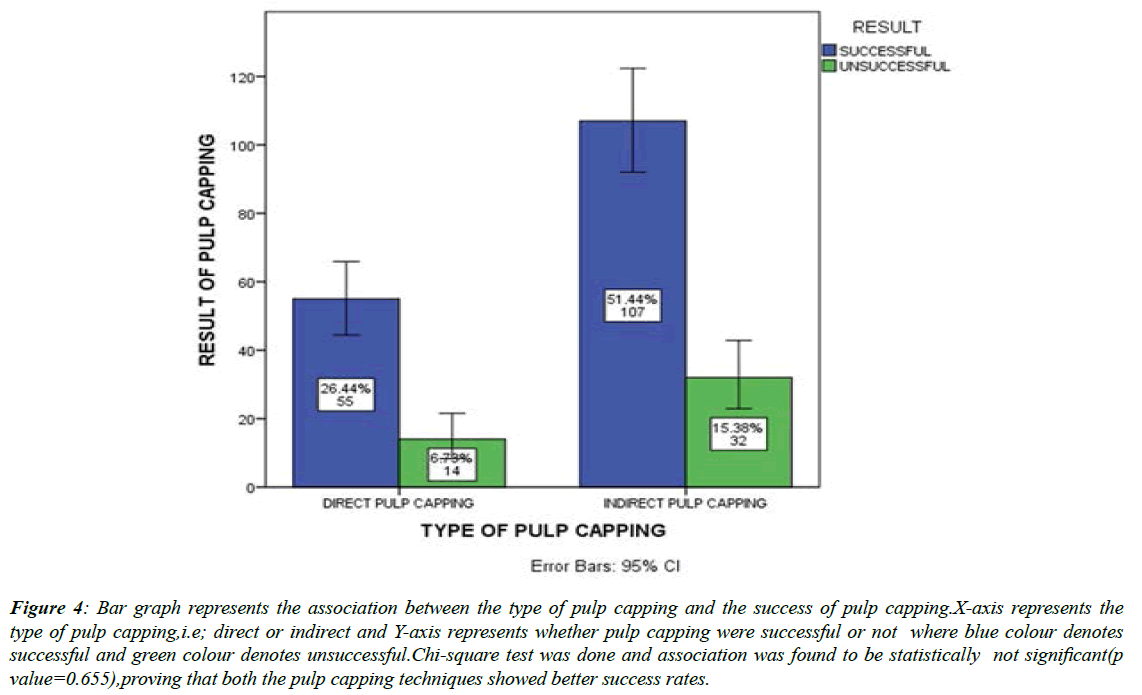Research Article - Journal of Clinical Dentistry and Oral Health (2022) Volume 6, Issue 3
Success of pulp capping in maxillary molars in adult patients- a retrospective study in an institutional setup.
Anubhav Das, Pradeep S*Department of Conservative Dentistry and Endodontics, Saveetha Dental College and Hospitals, Saveetha Institute of Medical and Technical Sciences (SIMATS), Chennai, Tamil Nadu, India
- *Corresponding Author:
- Pradeep S
Department of Conservative Dentistry and Endodontics
Saveetha Dental College and Hospitals
Saveetha Institute of Medical and Technical Sciences (SIMATS)
Chennai, Tamil Nadu, India
Tel No: 9710404482
E-mail: pradeeps@saveetha.com
Received: 15-Apr-2022, Manuscript No. AACDOH-22-60874; Editor assigned: 18-Apr-2022, PreQC No. AACDOH-22-60874 (PQ); Reviewed: 02-May-2022, QC No. AACDOH-22-60874; Revised: 05-May-2022, Manuscript No. AACDOH-22-60874 (R); Published: 12-May-2022, DOI:10.35841/aacdoh- 6.3.112
Citation: Das A, Pradeep S. Success of pulp capping in maxillary molars in adult patients- a retrospective study in an institutional setup. J Clin Dentistry Oral Health. 2022;6(3):112
Abstract
Aim: of this retrospective study was to evaluate the success rate of pulp-capping in maxillary molars in adult patients. Materials and Methods: Over a period of two years a total of 207 adult patients underwent pulp capping in the maxillary molars. Data was collected from dental college patient management software, it was tabulated in excel and then imported to SPSS software for statistical analysis and chi-square test was done to check for statistical significance. Results: It was that there was a statistically significant association between success of pulp capping and age (p value=0.000) and the tooth number (p value=0.003).There was no significant association between gender and success rate of pulp capping(p value=0.683) and also no significant association was found between the type of pulp capping and the success rate(p value=0.655). Conclusion: Patients with <45 yrs showed successful results for pulp capping procedures. Permanent molars showed promising results for both the pulp capping techniques (Direct and indirect pulp capping) in both the genders.
Keywords
Adult patients, Direct Pulp capping, Indirect Pulp capping, Molars, Permanent teeth.
Introduction
Pulp capping is a procedure in which a medicament, dressing, or dental material is placed directly over exposed dental pulp(direct pulp capping) or over very thin remaining dentin(indirect pulp capping) to preserve its vitality [1]. Treatment options in this situation include direct pulp capping, pulpotomy, or pulpectomy [2].conventionally direct pulp capping therapies were performed on young permanent teeth with pulp exposures. Many pulp capping materials have been used [3]. Removal of caries is one of the most basic aspects of conservative dentistry. Leave the remaining caries in place and return the tooth with a cavity sealer or liner and restore it, it is called an indirect pulp cap [4]. The main aim of pulp capping is to induce reparative tertiary dentin formation by pulp cells [5]. For many years, calcium hydroxide was the material of choice among the various available pulp-capping agents.Although calcium hydroxide has been the material of choice for many years, it presents some disadvantages, poor bonding to dentin, dissolution over time, and tunnel defects in the newly formed dentin bridges and poor sealing [6,7]. An alternative gold standard, mineral trioxide aggregate (MTA), is available as a direct pulp-capping material [8]. Other pulp capping agents such as biodentine are also widely used nowadays. In this retrospective study which is done in an institutional setup we will see the success of pulp capping in maxillary molars in adult patients.Our team has extensive knowledge and research experience that has translate into high quality publications [9-28].
Materials and Methods
The present study is a retrospective study, which was conducted in a university set up. The advantages for undertaking a study in a university setting are easy retrieval of records; the available data is from the same ethnicity of people. The disadvantages being the study are limited to one geographical location, limited population, same ethnicity. The university ethical committee approval was taken. The present study is a retrospective cross sectional study; the sampling is done between March 2020 to August 2021. 2166 cases were reviewed in this study in the above time span. Data of 207 patients was collected and analysed, all data of the adult patients who have undergone pulp capping in maxillary molars have been tabulated in a chronological order, data from excel was imported to SPSS software by IBM for statistical analysis, the variables was defined in SPSS.
The statistical test employed was the chi-square test. Independent variables being age group, sex and socio economic status. Dependent variables being type of pulp capping agents, success of pulp capping or not. The type of analysis done is correlation and association by descriptive data analysis.
Results
In this retrospective study, we found that there is no significant statistical association between success of pulp capping and gender, type of pulp capping and tooth number. there was a statistically significant association between success of pulp capping and age (p value=0.000) (Figure 1) There was no significant association between gender and success rate of pulp capping (p value=0.683) (Figure 2), and the tooth number (p value=0.003) (Figure 3), and also no significant association was found between the type of pulp capping and the success rate (p value=0.655) (Figure 4) respectively.
Figure 1: Bar graph represents the association between the age and the success of pulp capping.X-axis represents the age group of the patients and Y-axis represents whether pulp capping were successful or not where blue colour denotes successful and green colour denotes unsuccessful.Chi-square test was done and association was found to be statistically significant (p value=0.000),as the age increases (>45), the success of pulp capping becomes questionable and successful pulp capping is seen <45 yrs of age.
Figure 2: Bar graph represents the association between the gender and the success of pulp capping.X-axis represents the gender of the patients and Y-axis represents whether pulp capping were successful or not where blue colour denotes successful and green colour denotes unsuccessful.Chi-square test was done and association was found to be statistically not significant(p value=0.683),proving that both the gender showed promising results for pulp capping procedures.
Figure 3: Bar graph represents the association between tooth and the success of pulp capping.X-axis represents the tooth number and Y-axis represents whether pulp capping were successful or not where blue colour denotes successful and green colour denotes unsuccessful.Chisquare test was done and association was found to be statistically significant (p value=0.003),Permanent Molars showed more successful results for pulp capping.
Figure 4: Bar graph represents the association between the type of pulp capping and the success of pulp capping.X-axis represents the type of pulp capping,i.e; direct or indirect and Y-axis represents whether pulp capping were successful or not where blue colour denotes successful and green colour denotes unsuccessful.Chi-square test was done and association was found to be statistically not significant(p value=0.655),proving that both the pulp capping techniques showed better success rates.
Discussion
Indeed, the success rate of pulp capping as documented in the literature has varied between the short-term and long-term follow-up. When iatrogenic pulpal exposures occurred while caries removal, in most situations, the recommendation was to perform pulpotomy and pulpectomies. There was a significant statistical association between success of pulp capping and age (Figure 1). This finding is in accordance with [29], who reported that age had significant effects on the success rate of pulp capping. Dammaschke et al. [30, 31] reported significantly lower favorable treatment outcomes for direct pulp capping in the more than 60 years old patients, compared to patients younger than 40 years old. Another study, [32] found significant differences between the youngest patients (i.e., 10–29 years) and the oldest patients (i.e., 50–79 years). In another study reported by Armstrong and Hoffman [33,34], the lack of clinical symptomatology after 1.5 years was the criterion for success of the pulp capping. Some studies have shown that younger patients experienced better success with pulp capping [30,31], whereas some studies could not confirm the influence of age on the outcome of direct pulp capping [34-37].Treatment of pulp exposures by pulp capping still is controversial. Clinicians are well-aware of the immediate and long-term success rates of endodontic therapy but are less certain of the success of pulp capping [38]. Berman [39] stated that pulp capping is the most misused, abused, unpredictable and least successful of the pulp therapy alternatives, with success rates of only 30 to 40 percent. Kakehashi and colleagues [40] showed clearly that exposed pulp heals well in the absence of bacteria, with dentin bridge formation occurring. This difference in result may be because of the different age groups which were analyzed in those studies. Another study also reported that compared with 60-year-old patients, patients younger than 40 years of age had significantly better outcomes [30]. However, some studies could not confirm an influence of age on the success or failure of pulp-capped teeth [36, 41].The higher success rate for patients younger than 45 years can be explained by the high healing capacity of pulp tissue in young patients. Indirect comparison of the weighted pooled success rate in teeth with an open apex (i.ehigher healing capacity of the pulp tissue) or closed apex showed statistically more successful outcomes in teeth with incomplete root development [42]. However, further clinical studies with a higher number of patients are needed to re-evaluate the age-related influence on treatment outcome after pulp capping with Biodentine.
Conclusion
Within the limitations of the study, we can conclude that patients with <45 yrs showed successful results for pulp capping procedures. Permanent molars showed promising results for both the pulp capping techniques (Direct and indirect pulp capping) in both the genders. As a result one can preserve the tooth by doing pulp capping procedures.
Conflict of Interest
None to declare.
Acknowledgements
I would like to show our gratitude to the Director of Academics, DR. Deepak Nallasamy Veeraiyan, Saveetha Institute of Medical and Technical Sciences, for sharing his pearls of wisdom with us during the course of this research, and we thank the reviewers for their so-called insights. We are also immensely grateful to the Department of Conservative Dentistry and Endodontics,Saveetha Dental College for their comments on an earlier version of the manuscript, although any errors are our own and should not tarnish the reputations of these esteemed persons.
Source of Funding
The present study was supported by the following agencies:
1. Saveetha Dental College
2. Saveetha Institute of Medical and Technical Science
3. Sarkav Healthcare services
References
- Dammaschke T. The history of direct pulp capping. J Hist Dent. 2008;56:9–23.
- Murray PE, Hafez AA, Smith AJ, et al. Hierarchy of pulp capping and repair activities responsible for dentin bridge formation. Am J Dent. 2002;15:236–43.
- Tucker RL, Ha WN. A Systematic Review Comparing Mineral Trioxide Aggregate to Other Commercially Available Direct Pulp Capping Agents in Dogs. J Vet Dent. 2021;38:34–45.
- Oen KT, Thompson VP, Vena D, et al. Attitudes and expectations of treating deep caries: a PEARL Network survey. Gen Dent. 2007;55:197–203.
- Heymann HO, Swift EJ Jr, Ritter AV. Sturdevant’s Art & Science of Operative Dentistry - E-Book. Elsevier Health Sciences. 2014.
- Murray PE, Windsor LJ, Smyth TW, et al. Analysis of pulpal reactions to restorative procedures, materials, pulp capping, and future therapies. Crit Rev Oral Biol Med. 2002;13:509–20.
- Bergenholtz G, Lindhe J. Effect of soluble plaque factors on inflammatory reactions in the dental pulp. Scand J Dent Res. 1975;83:153–8.
- Al-Zayer MA, Straffon LH, Feigal RJ, et al. Indirect pulp treatment of primary posterior teeth: a retrospective study. Pediatric Dent. 2003;25(1):29-36.
- Muthukrishnan L. Imminent antimicrobial bioink deploying cellulose, alginate, EPS and synthetic polymers for 3D bioprinting of tissue constructs. Carbo Poly. 2021;260:117774.
- PradeepKumar AR, Shemesh H, Nivedhitha MS, et al. Diagnosis of vertical root fractures by cone-beam computed tomography in root-filled teeth with confirmation by direct visualization: a systematic review and meta-analysis. J Endo. 2021;47(8):1198-214.
- Chakraborty T, Jamal RF, Battineni G, et al. A review of prolonged post-COVID-19 symptoms and their implications on dental management. Int J Environ Res Public Health. 2021;18(10):5131.
- Muthukrishnan L. Nanotechnology for cleaner leather production: a review. Environ Chem Lett. 2021;19(3):2527-49.
- Teja KV, Ramesh S. Is a filled lateral canal–A sign of superiority?. J Dent Sci. 2020;15(4):562.
- Narendran K, MS N, Sarvanan A. Synthesis, Characterization, Free Radical Scavenging and Cytotoxic Activities of Phenylvilangin, a Substituted Dimer of Embelin. Ind J Pharmac Sci. 2020;82(5):909-12.
- Reddy P, Krithikadatta J, Srinivasan V, et al. Dental caries profile and associated risk factors among adolescent school children in an urban South-Indian city. Oral Health Prev Dent. 2020;18(1):379-86.
- Sawant K, Pawar AM, Banga KS, et al. Dentinal Microcracks after Root Canal Instrumentation Using Instruments Manufactured with Different NiTi Alloys and the SAF System: A Systematic Review. App Sci. 2021;11(11):4984.
- Bhavikatti SK, Karobari MI, Zainuddin SL, et al. Investigating the Antioxidant and Cytocompatibility of Mimusops elengi Linn Extract over Human Gingival Fibroblast Cells. Int J Enviro Res Public Hea. 2021;18(13):7162.
- Karobari MI, Basheer SN, Sayed FR, et al. An In Vitro Stereomicroscopic Evaluation of Bioactivity between Neo MTA Plus, Pro Root MTA, BIODENTINE & Glass Ionomer Cement Using Dye Penetration Method. Mat. 2021;14(12):3159.
- Rohit Singh T, Ezhilarasan D. Ethanolic extract of Lagerstroemia Speciosa (L.) Pers., induces apoptosis and cell cycle arrest in HepG2 cells. Nutr Cancer. 2020;72(1):146-56.
- Ezhilarasan D. MicroRNA interplay between hepatic stellate cell quiescence and activation. Euro J Pharmacol. 2020;885:173507.
- Romera A, Peredpaya S, Shparyk Y, et al. Bevacizumab biosimilar BEVZ92 versus reference bevacizumab in combination with FOLFOX or FOLFIRI as first-line treatment for metastatic colorectal cancer: a multicentre, open-label, randomised controlled trial. Lancet Gastroenterol Hepatol. 2018;3(12):845-55.
- Raj R K. β‐Sitosterol‐assisted silver nanoparticles activates Nrf2 and triggers mitochondrial apoptosis via oxidative stress in human hepatocellular cancer cell line. J Biomed Mat Res Part A. 2020;108(9):1899-908.
- Vijayashree Priyadharsini J. In silico validation of the non‐antibiotic drugs acetaminophen and ibuprofen as antibacterial agents against red complex pathogens. J Periodontol. 2019;90(12):1441-8.
- Priyadharsini JV, Girija AS, Paramasivam A. In silico analysis of virulence genes in an emerging dental pathogen A. baumannii and related species. Archiv Oral Biol. 2018;94:93-8.
- Uma Maheswari TN, Nivedhitha MS, Ramani P. Expression profile of salivary micro RNA-21 and 31 in oral potentially malignant disorders. Braz Oral Res. 2020;34.
- Gudipaneni RK, Alam MK, Patil SR, et al. Measurement of the maximum occlusal bite force and its relation to the caries spectrum of first permanent molars in early permanent dentition. J Clini Pediatr Dent. 2020;44(6):423-8.
- Chaturvedula BB, Muthukrishnan A, Bhuvaraghan A, et al. Dens invaginatus: a review and orthodontic implications. Br Dent J. 2021;230(6):345-50.
- Kanniah P, Radhamani J, Chelliah P, et al. Green synthesis of multifaceted silver nanoparticles using the flower extract of Aerva lanata and evaluation of its biological and environmental applications. Chem Select. 2020;5(7):2322-31.
- Cho S-Y, Seo D-G, Lee S-J, et al. Prognostic factors for clinical outcomes according to time after direct pulp capping. J Endod. 2013;39:327–31.
- Dammaschke T, Leidinger J, Schäfer E. Long-term evaluation of direct pulp capping--treatment outcomes over an average period of 6.1 years. Clin Oral Investig. 2010;14:559–67.
- Horsted P, Sandergaard B, Thylstrup A, et al. A retrospective study of direct pulp capping with calcium hydroxide compounds. Endod Dent Traumatol. 1985;1:29–34.
- Fuks A, Peretz B. Pediatric Endodontics: Current Concepts in Pulp Therapy for Primary and Young Permanent Teeth. Springer. 2016.
- Armstrong WP, Hoffman S. Pulp-cap study. Oral Surg Oral Medi Oral Patho. 1962. 1505–9.
- Barthel CR, Rosenkranz B, Leuenberg A, et al. Pulp capping of carious exposures: treatment outcome after 5 and 10 years: a retrospective study. J Endo. 2000;26(9):525-8.
- Mente J, Geletneky B, Ohle M, et al. Mineral trioxide aggregate or calcium hydroxide direct pulp capping: an analysis of the clinical treatment outcome. J Endo. 2010;36(5):806-13.
- Matsuo T, Nakanishi T, Shimizu H, et al. A clinical study of direct pulp capping applied to carious-exposed pulps. J Endod. 1996;22:551–6.
- Al-Hiyasat AS, Barrieshi-Nusair KM, Al-Omari MA. The radiographic outcomes of direct pulp-capping procedures performed by dental students: a retrospective study. J Am Dent Assoc. 2006;137:1699–705.
- Stanley HR. Criteria for standardizing and increasing credibility of direct pulp capping studies. Am J Dent. 1998;11:S17–34.
- Berman MH. Pulpotomy: the old reliable pulp therapy. Dent Today. 1996;15:60, 62–7.
- Kakehashi S, Stanley HR, Fitzgerald RJ. The effects of surgical exposures of dental pulps in germ-free and conventional laboratory rats. Oral Surg Oral Medi Oral Pathol. 1965;20(3):340-9.
- Mente J, Geletneky B, Ohle M, et al. Mineral trioxide aggregate or calcium hydroxide direct pulp capping: an analysis of the clinical treatment outcome. J Endo. 2010;36(5):806-13.
- Aguilar P, Linsuwanont P. Vital pulp therapy in vital permanent teeth with cariously exposed pulp: a systematic review. J Endod. 2011;37:581–7.
Indexed at, Google Scholar, Cross Ref
Indexed at, Google Scholar, Cross Ref
Indexed at, Google Scholar, Cross Ref
Indexed at, Google Scholar, Cross Ref
Indexed at, Google Scholar, Cross Ref
Indexed at, Google Scholar, Cross Ref
Indexed at, Google Scholar, Cross Ref
Indexed at, Google Scholar, Cross Ref
Indexed at, Google Scholar, Cross Ref
Indexed at, Google Scholar, Cross Ref
Indexed at, Google Scholar, Cross Ref
Indexed at, Google Scholar, Cross Ref
Indexed at, Google Scholar, Cross Ref
Indexed at, Google Scholar, Cross Ref
Indexed at,Google Scholar, Cross Ref
Indexed at, Google Scholar, Cross Ref
Indexed at, Google Scholar, Cross Ref
Indexed at, Google Scholar, Cross Ref
Indexed at, Google Scholar, Cross Ref
Indexed at, Google Scholar, Cross Ref
Indexed at, Google Scholar, Cross Ref
Indexed at, Google Scholar, Cross Ref
Indexed at, Google Scholar, Cross Ref
Indexed at, Google Scholar, Cross Ref
Indexed at, Google Scholar, Cross Ref



